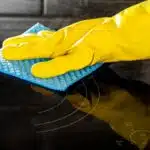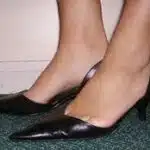As a leather care expert, I have come across many homeowners who wish to condition their leather but are unaware of the proper techniques and products to use. Leather is a beautiful and durable material that can last for years if cared for properly, but it can also become brittle and dry without proper conditioning. In this article, I will share my knowledge on how to condition leather around your home using simple techniques and natural products.
Leather conditioning is an essential part of leather care as it keeps the material supple and prevents cracking or peeling. There are several ways to condition leather, such as using commercial products or natural oils like coconut oil or beeswax. However, not all methods work well for every type of leather, and some products may cause damage instead of nourishing the material. Therefore, it is crucial to understand the different types of leather and which method works best for each one. By following the tips discussed in this article, you’ll be able to keep your leather items looking new for years to come while also preserving their quality and value.
The Importance Of Leather Conditioning
Leather goods are a staple in many households, and they require proper care to maintain their quality and longevity. One of the most important aspects of leather care is conditioning. Conditioning helps to restore the natural oils that keep leather supple and prevent it from drying out, cracking, or becoming brittle. It also helps to protect against stains and other forms of damage.
The benefits of leather conditioning are numerous. Regular conditioning can extend the life of your leather goods by preventing them from drying out over time. It also helps to maintain their appearance by keeping them looking clean and polished. Additionally, conditioned leather is more resistant to wear and tear, making it an excellent investment for those who want their leather items to last for years.
There are several best practices when it comes to leather conditioning. First, always test any new products on a small, inconspicuous area before applying them to the entire surface. Second, be sure to follow the manufacturer’s instructions carefully, as different types of leather may require different techniques or products. Finally, avoid over-conditioning your leather goods, as this can cause them to become too soft or oily.
Understanding different types of leather is essential when it comes to choosing the right technique for conditioning. Different leathers have varying levels of absorbency and require different amounts of conditioner. By taking the time to learn about your specific type of leather and how best to condition it, you can ensure that your items stay looking their best for years to come.
Understanding Different Types Of Leather
After understanding the importance of conditioning leather, it’s essential to comprehend the different types of leather before choosing the right conditioning product. Leather is a versatile and durable material that comes in many forms, each with unique attributes that influence its quality. An overview of these factors can help you select the best conditioning method for your leather.
The first factor that affects leather quality is the animal from which it originates. For example, cowhide is thicker and more durable than lamb or goat skin, making it suitable for heavy-duty items like furniture and boots. Another factor is the tanning process used to preserve and protect the hide. Chrome-tanned leather has a more polished appearance than vegetable-tanned leather but is less environmentally friendly due to its use of chemicals.
Understanding these factors will help you determine which conditioning product works best for your specific type of leather. When selecting a conditioner, consider whether it contains natural ingredients such as beeswax or lanolin, as these substances penetrate deep into the pores of the leather to nourish and moisturize it. You should also choose a product that matches your intended use; some conditioners are designed for specific items like car seats or footwear.
Choosing the right conditioning product is crucial in maintaining your leather’s quality over time. By taking into account the type of leather you have and its intended use, you can ensure that you provide proper care to extend its lifespan and keep it looking new. With this knowledge in mind, let’s dive deeper into understanding different types of leather before discussing specific products for conditioning.
Choosing The Right Conditioning Product
When it comes to conditioning leather, choosing the right product is crucial. There are many options available on the market today, each with its own unique benefits and drawbacks. It’s important to consider both natural and synthetic options when making your decision.
Natural conditioning products are often made from ingredients like beeswax, lanolin, and coconut oil. These products tend to be gentler on leather than some synthetic options and can help to restore the leather’s natural oils. However, they may not be as effective at protecting against water damage or other environmental factors.
Synthetic conditioning products are typically made from chemicals that have been specifically designed to protect and nourish leather. They can provide a high level of protection against water damage, UV rays, and other environmental factors. However, some people may find these products to be harsher on their leather than natural alternatives.
When choosing a conditioning product for your leather items, it’s important to consider your specific needs and preferences. If you’re looking for a gentle option that will help restore your leather’s natural oils, a natural product may be the best choice for you. On the other hand, if you’re looking for maximum protection against environmental factors, a synthetic product may be more appropriate.
Natural Oils For Leather Conditioning
Leather is a natural material that requires proper care and maintenance to maintain its quality and durability. One of the best ways to condition leather is by using natural oils. Natural oils are safe, effective, and easy to apply. The best natural oils for conditioning leather include olive oil, coconut oil, and jojoba oil.
Olive oil is an excellent natural oil for conditioning leather because it penetrates deep into the pores of the leather and softens it from within. It also helps restore the lost moisture content in your leather products. To use olive oil for conditioning your leather goods, simply apply a small amount onto a clean cloth and gently rub it into the leather in circular motions.
Coconut oil is another great natural oil for conditioning leather. It helps prevent cracking and drying of the leather by providing it with essential nourishment. To condition your leather products using coconut oil, warm a small amount between your palms and massage it into the surface of the leather in gentle circular motions until the entire surface is covered.
Jojoba oil is a versatile natural oil that works wonders on all types of leathers, including suede and nubuck leathers. It provides deep nourishment to the fibers of your leathers without leaving any greasy residue behind. To condition your leathers using jojoba oil, mix equal parts of jojoba oil and beeswax in a double boiler until they melt together completely. Apply this mixture onto your leathers with a clean cloth in gentle circular motions.
If you prefer DIY methods, then these natural oils can be combined with other ingredients to create homemade conditioning recipes that suit specific needs or preferences. However, commercial-grade leather conditioners are also available if you want to save time or prefer ready-made options over DIY methods. The next section will discuss some popular commercial-grade options available in the market today.
Commercial Leather Conditioners
- Commercial leather conditioners come in a variety of types, each of which is specifically formulated to meet the needs of different leather surfaces.
- Common ingredients in commercial leather conditioners include oils, waxes, and other compounds intended to restore suppleness and durability to leather.
- Various types of oils are used in commercial leather conditioners, such as mineral oils, vegetable oils, and animal fats, each of which have different properties and benefits.
- Waxes, such as beeswax, carnauba, and paraffin, are also commonly used in commercial leather conditioners, and provide a protective layer against moisture and dirt.
Types Of Commercial Leather Conditioners
As a leather care expert, it is important to understand the different types of commercial leather conditioners available in the market. DIY leather conditioners are one option that many people turn to, however, these can be risky as they may not be formulated correctly and can damage the leather. It is always advisable to use a commercial product that has been specifically designed for the type of leather you are working with.
Eco-friendly leather conditioners are becoming increasingly popular amongst consumers who want to make more sustainable choices for their homes and lifestyles. These products are made from natural ingredients such as beeswax, plant oils, and lanolin, and do not contain any harsh chemicals or additives. They effectively moisturize and protect the leather without causing any harm to the environment.
When choosing a commercial leather conditioner, it is important to consider factors such as the type of leather you have, its age and condition, and your personal preferences in terms of sustainability and eco-friendliness. With so many options available in the market today, there is no reason why you cannot find a product that meets your specific needs and helps keep your leather items looking their best for years to come.
Ingredients In Commercial Leather Conditioners
As a leather care expert, it is important to understand the ingredients used in commercial leather conditioners. These products are formulated with various ingredients that provide nourishment and protection to different types of leather. Some common ingredients found in commercial leather conditioners include oils, waxes, and polymers. It is crucial to choose a conditioner that is specifically designed for your type of leather and follow safety precautions when using these products.
When using commercial leather conditioners, it is important to read the label carefully and understand the ingredients used. Some conditioners may contain harsh chemicals or additives that can damage your leather items if not used correctly. Always follow the manufacturer’s instructions and use gloves to protect your hands from any potential irritation or allergic reactions.
To ensure the longevity of your leather items, it is important to choose a high-quality conditioner that contains natural ingredients such as beeswax, lanolin, or plant oils. These ingredients effectively moisturize and protect the leather without causing any harm to the environment. When selecting a conditioner, consider its sustainability and eco-friendliness as well as its effectiveness in maintaining your leather items’ quality for years to come.
Testing A Small Area Before Conditioning
After exploring the commercial leather conditioners available in the market, it is important to test a small area of the leather before proceeding with conditioning. This step ensures that there are no allergic reactions or adverse effects on the leather caused by the conditioner. Testing methods vary depending on the type of leather being conditioned and the type of conditioner used.
One effective testing method is to apply a small amount of conditioner onto a hidden or inconspicuous area of the leather, such as underneath a cushion or behind a leg rest. Allow it to absorb for 24 hours and check for any discoloration or adverse reactions. If there are no negative effects, proceed with conditioning larger areas.
It is also important to be aware that different types of leather may react differently to conditioners. For example, full-grain leather may darken slightly when conditioned, while suede may become matted if too much conditioner is applied. Therefore, it is crucial to read and follow the instructions provided by the manufacturer and use a suitable product for your specific type of leather.
4 Tips for Testing Leather Conditioner:
- Choose an inconspicuous area to test
- Apply a small amount of conditioner
- Wait 24 hours before checking for discoloration or reactions
- Follow manufacturer’s instructions
Next, we will discuss how to prepare the leather for conditioning and what steps you should take to ensure optimal results.
Preparing The Leather For Conditioning
As we begin to discuss how to condition leather around your home, it is important to note that proper preparation of the leather is essential for achieving the desired results. One common misconception about conditioning leather is that it can be done without prior cleaning. However, this couldn’t be further from the truth. Leather cleaning must be done before conditioning as it helps remove any dirt, grime, or stains present on the surface.
Once you have cleaned the leather, the next step is to prepare it for conditioning. This involves opening up the pores of the leather so that it can absorb the conditioning product better. To achieve this, you can use a leather preparation solution or a mixture of equal parts water and rubbing alcohol. Apply this solution using a soft cloth and rub gently in circular motions until you notice the pores opening up.
To emphasize just how important preparing your leather for conditioning is, take a look at this table:
| Leather Cleaning | Leather Preparation |
|---|---|
| Removes dirt & grime | Opens up pores of leather |
| Improves absorption of conditioner | Helps achieve desired results |
By taking the time to properly clean and prepare your leather before applying a conditioning product, you are ensuring that your efforts will not go to waste. Remember that good preparation leads to great results! In our next section, we will discuss how to apply the conditioning product onto your prepared leather surface.
Applying The Conditioning Product
After preparing the leather, it is time to move on to applying the conditioning product. Applying techniques vary depending on the type of product used. A common rule of thumb is to start with a small amount of product and gradually build up as needed. This ensures that the leather does not become oversaturated, which can lead to discoloration or damage.
Product selection tips are important when considering what conditioning product to use. It is essential to choose a product that is specifically designed for the type of leather being conditioned. Leather conditioners come in different forms such as creams, balms, and oils. Creams and balms tend to be better for soft leathers like suede or nubuck, while oils work well on tougher leathers like full-grain or top-grain. It’s also important to avoid products that contain harsh chemicals or silicones.
To achieve optimal results, massaging the leather during application is crucial. This helps distribute the conditioner evenly across all areas of the leather and ensures maximum absorption. Using circular motions with a clean cloth or sponge allows for gentle pressure while working in the conditioner. After covering all areas of the leather, allow it to sit for a few minutes before wiping off any excess conditioner with a clean cloth.
By following these guidelines and applying proper techniques, conditioning your leather will help maintain its longevity and overall appearance. Keep in mind that regular maintenance is key in preserving your leather items and preventing premature wear and tear. Next, we will discuss additional tips for maintaining your leather goods beyond just conditioning them regularly – including how to store them properly!
Massaging The Leather For Best Results
Satire is a powerful tool when it comes to leather care. Imagine for a moment that you are giving your leather couch a massage, just like you would do with your partner after a long day at work. You run your hands over the soft surface, feeling the tension in the leather melt away under your expert touch. The only difference is that instead of aromatherapy oils, you’re using leather conditioner.
Technique tips are important when it comes to massaging leather. One of the most important things to remember is to use circular motions. This helps to distribute the conditioner evenly across the surface of the leather. You should also avoid using too much pressure as this can damage the material. A gentle touch is all that’s needed to get great results.
Hand massage benefits extend beyond just making your leather look great. Massaging your leather helps to soften and condition it, making it more supple and less prone to cracking or drying out over time. It also helps to restore natural oils and moisturize the material, which can help prolong its lifespan. By taking good care of your leather furniture, you’ll be able to enjoy it for years to come.
As you finish massaging your leather, it’s important to let it rest and absorb the product before using it again. This will give the conditioner time to penetrate deep into the pores of the material, nourishing it from within. A good rule of thumb is to wait at least 15 minutes before wiping away any excess conditioner with a clean cloth. With regular maintenance and proper care techniques like hand massage, your leather furniture will stay looking beautiful for years to come!
Letting The Leather Rest And Absorb The Product
After applying the conditioner, it is important to let the leather rest for a certain amount of time. This rest period allows the product to penetrate deep into the pores of the leather and nourish it from within. Rest time can vary depending on the type of conditioner used and the absorption rate of your leather. As a general rule, it is recommended to let the leather sit for at least 30 minutes before touching or using it.
During this rest period, it is also important to ensure that your leather is in a well-ventilated area. This will help facilitate the absorption process while preventing any unwanted odors or mold growth. It is also advisable to keep your leather away from direct sunlight or heat sources as these can dry out and damage the material.
To make sure that your leather has absorbed enough conditioner, you can perform a simple touch test. Lightly press your finger onto an inconspicuous area of the leather and observe how quickly it bounces back. If it takes more than a few seconds for the impression to disappear, then your leather may need more rest time.
- Check manufacturer’s instructions on recommended rest time
- Keep leather in well-ventilated area during rest period
- Avoid exposing leather to direct sunlight or heat sources
- Perform touch test to determine if enough conditioner has been absorbed
- Patience is key; do not rush this step
As we move forward with our care routine, buffing comes next in line after resting and absorbing have taken place. Buffing helps smooth out any rough spots or unevenness on the surface of your treated leather while giving it a polished finish.
Buffing The Leather For A Smooth Finish
Ah, the satisfying feeling of leather that’s been freshly conditioned! But wait, there’s more to it than just slathering on some conditioner and calling it a day. To get that smooth, polished finish you’re after, you’ll need to use some buffing techniques. Don’t worry, it’s not as daunting as it sounds.
Before we dive into the equipment needed for buffing, let’s talk about why it’s important. Not only does buffing give your leather a sleek appearance, but it also helps to evenly distribute the conditioner across the surface. Without buffing, you may end up with an uneven finish or even attract dirt and dust to your newly-conditioned leather. Nobody wants that!
Now onto the fun part – equipment needed for buffing leather. You’ll want to have a soft cloth or microfiber towel on hand (avoid anything too abrasive), as well as a horsehair brush or sponge. Depending on the type of conditioner you’re using, you may also need a special applicator pad. Be sure to read the product instructions carefully before starting.
Transition: Now that you know how to properly buff your leather for a smooth finish, let’s discuss how often you should be conditioning your leather goods.
How Often To Condition Leather
Leather is a durable and versatile material that can last for many years with proper care. One of the most important steps in maintaining the quality of leather is conditioning it regularly. The frequency of conditioning depends on various factors, such as how often the leather is used, its exposure to sunlight and heat, and the overall condition of the leather.
As a general rule, experts recommend conditioning leather every three to six months. However, this can vary depending on the type of leather and its usage. For example, leather items that are exposed to harsh weather conditions or frequent wear may require more frequent conditioning. On the other hand, leather items that are used infrequently or kept in storage may only need to be conditioned once a year.
It’s important to note that over-conditioning can be detrimental to leather. Signs of over-conditioning include a sticky or oily surface, discoloration, and an unpleasant odor. If you notice any of these signs after conditioning your leather item, it’s best to stop immediately and let it dry out before attempting to condition it again.
Properly maintaining your leather items not only prolongs their lifespan but also ensures their continued beauty and functionality. In addition to regular conditioning, storing your leather items properly is another key factor in preserving their quality.
Storing Leather Items Properly
When choosing a storage space for leather items, it is important to consider the environment of the area in terms of temperature, humidity, and light. Preparing leather items for storage includes cleaning the surface of any dirt or debris and conditioning the leather with a product formulated specifically for leather. Additionally, it is important to check the leather items for signs of damage or wear before storing them, addressing any issues that are found. Finally, it is essential to ensure that leather items are stored away from direct sunlight and in a dry, cool space to prevent fading and cracking.
Choosing A Storage Space
When it comes to storing leather items, choosing the right storage space is crucial to ensuring their longevity. One important factor to consider is maximizing space. Leather items should be stored in an area with enough space for air circulation and minimal contact with other items, which can cause scratching or stretching. This means avoiding stuffing leather bags or jackets into tight spaces, and instead opting for a hanging rack or shelf.
Another key consideration when selecting a storage space for leather items is climate control options. Leather is sensitive to fluctuations in temperature and humidity, which can cause cracking or warping over time. To prevent this, it’s best to store leather in a room with consistent temperature and humidity levels. If you don’t have access to a climate-controlled environment, consider using silica gel packs or dehumidifiers to regulate moisture in the air.
Ultimately, taking the time to choose the right storage space for your leather items can go a long way in preserving their quality and extending their lifespan. By maximizing space and considering climate control options, you can ensure that your cherished leather pieces will remain beautiful and functional for years to come.
Preparing The Leather Items
As a leather care expert, it’s important to emphasize that proper preparation of leather items is crucial for their longevity. Before storing leather items, it’s essential to clean them thoroughly using the appropriate cleaning techniques. This ensures that any dirt or debris on the leather surface is removed, preventing potential damage and discoloration over time.
For those who prefer DIY leather preparation, there are several methods to consider. One common method involves using a mixture of water and mild soap to gently clean the item with a soft cloth. Another option is to use a specialized leather cleaner specifically designed for the type of leather being cleaned. It’s important to avoid using harsh chemicals or abrasive materials during this process, as these can cause irreversible damage to the leather.
After cleaning, it’s also recommended to apply a conditioner or protective spray to the leather item. This helps to keep the material supple and moisturized, preventing cracking and other forms of damage caused by dryness over time. By taking the time to properly prepare your leather items before storage, you can ensure that they remain in excellent condition for years to come.
Common Mistakes To Avoid When Conditioning Leather
Leather is a premium material that requires proper care and attention to maintain its quality. Leather conditioning is an essential part of leather care, but it can be a tricky process if not done correctly. Here are some common mistakes to avoid when conditioning leather and prevention tips:
Firstly, one of the most common mistakes people make is using too much conditioner on their leather items. Over-conditioning can cause the leather to become saturated with oils, which can weaken the fibers and cause discoloration or greasiness. To prevent this, it’s important to use only a small amount of conditioner and work it into the leather in circular motions. Additionally, you should wait for the conditioner to soak in before applying more.
Secondly, another mistake people make when conditioning leather is using the wrong type of conditioner for their specific item. Different types of leather require different kinds of conditioners; for example, suede requires a special type of conditioner compared to smooth finished leathers. Using the wrong product can lead to discoloration or damage to your item. To avoid this mistake, always read the label carefully and ensure that you’re choosing the right product for your particular piece.
Lastly, many people forget that cleaning their item thoroughly before conditioning it is essential. Dirt and grime can accumulate over time on leather surfaces, which can trap moisture beneath them and create mildew or mold problems. Before conditioning your item, it’s crucial to clean it first with a damp cloth or brush gently to remove any debris or dirt.
Prevention Tips Table:
| Common Mistakes | Prevention Tips |
|---|---|
| Over-conditioning | Use only a small amount of conditioner |
| Wrong type of conditioner | Read labels carefully; choose appropriate product |
| Failure to clean beforehand | Clean item thoroughly before applying conditioner |
In summary, avoiding these common mistakes will help preserve your leather items’ quality and extend their lifespan. By using the right conditioner, applying it correctly, and cleaning your item beforehand, you can ensure that your leather products stay in excellent condition for years to come.
Transition: Now that we’ve covered common mistakes to avoid when conditioning leather, let’s move on to troubleshooting common issues that may arise during the process.
Troubleshooting Common Leather Conditioning Issues
Just like a gardener who tends to their plants, conditioning leather involves caring for it regularly. However, even with the best intentions, things can go wrong. Fixing discoloration or dealing with sticky residue can be frustrating, but there are solutions to these common issues.
When it comes to fixing discoloration on leather, prevention is key. Always test your conditioner on a small, inconspicuous area before applying it to the entire surface. If you do experience discoloration after conditioning, try using a leather cleaner specifically designed for removing stains. Be sure to follow the instructions carefully and avoid using too much water as this can cause further damage.
Dealing with sticky residue can also be a headache. This issue often occurs when too much conditioner is applied or when the conditioner isn’t fully absorbed into the leather. To fix this problem, try wiping down the affected area with a damp cloth and allowing it to air dry completely before attempting to condition again. If the sticky residue persists, a leather degreaser may be necessary. Remember to always read and follow product instructions carefully.
- Tips for fixing discoloration:
- Prevention is key: always test your conditioner on a small area first
- Use a leather cleaner designed for removing stains
- Tips for dealing with sticky residue:
- Wipe down affected area with damp cloth and allow it to air dry completely
- Consider using a leather degreaser if residue persists
As a leather care expert, I understand how frustrating it can be when things don’t go as planned during conditioning. However, by following these tips and taking preventative measures, you can avoid these common issues altogether. Remember that patience and attention to detail are essential in caring for your leather goods effectively. With proper care, your leather items will last for many years to come without any major issues.
So whether you’re dealing with discoloration or sticky residue on your leather, don’t panic! There are solutions available to help you get your leather back to its original condition. By taking the time to identify the issue and using the appropriate products and techniques, you’ll be able to successfully troubleshoot any issues that may arise during the conditioning process.
Conclusion
As a leather care expert, understanding how to properly condition your leather items is essential for maintaining their longevity and beauty. By using the right conditioning product and technique, you can ensure that your leather will remain soft, supple, and free from cracks or other damage.
When it comes to choosing a conditioning product, it’s important to consider the type of leather you’re working with. Different types of leather require different levels of moisture and protection, so be sure to do your research before making a purchase. Natural oils like olive oil or coconut oil can also be effective for conditioning leather, but be cautious as they may darken or stain lighter colored leathers.
Properly storing your leather items is another crucial factor in their maintenance. Avoid exposing them to direct sunlight or extreme temperatures and always keep them stored in a breathable container or bag. And if you do experience issues with your leather despite proper care, don’t hesitate to consult with a professional for assistance.
In conclusion, proper conditioning of your leather items is essential for maintaining their quality and appearance. With the right knowledge and techniques at hand, you can ensure that your beloved leather pieces will continue to bring joy and style for years to come. As the saying goes: “A little bit of care today can go a long way tomorrow.”
Image Credits
- “Leather gloves” by Yamashiro-slugonleather (featured)





























